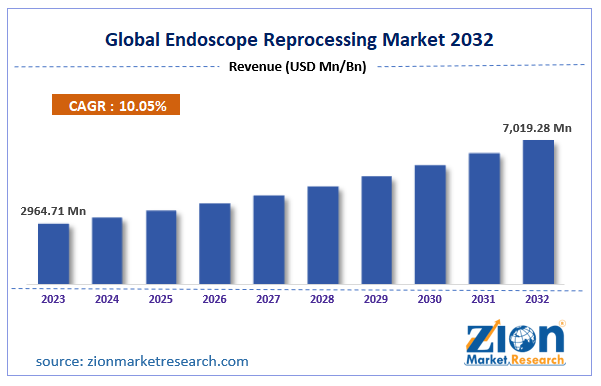Endoscope Reprocessing Market Size, Share, Growth Report 2032
The endoscope reprocessing market involves the cleaning, disinfection, and sterilization of endoscopic instruments used in medical procedures. Proper reprocessing is critical to ensuring the safety and effectiveness of endoscopes, which are used for diagnostic and therapeutic purposes in various medical fields. Here's an overview of the endoscope reprocessing market:

Get a Free Sample : https://www.zionmarketresearch.com/sample/endoscope-reprocessing-market
1. Market Overview:
- Increasing Endoscopic Procedures: The rising number of endoscopic procedures, driven by advancements in minimally invasive techniques and growing prevalence of chronic diseases, is fueling demand for effective endoscope reprocessing solutions.
- Focus on Infection Control: There is a growing emphasis on infection control and patient safety, leading to increased adoption of advanced reprocessing technologies and protocols.
2. Key Components of Endoscope Reprocessing:
- Cleaning: The initial stage involves the removal of organic and inorganic materials from the endoscope surfaces using enzymatic detergents and manual or automated cleaning systems.
- Disinfection: This stage involves applying high-level disinfectants (HLD) to kill microorganisms on the endoscope. Methods include chemical disinfectants, such as glutaraldehyde and ortho-phthalaldehyde (OPA), and heat-based methods.
- Sterilization: For endoscopes that require sterilization, methods such as steam sterilization (autoclaving) and low-temperature sterilization (e.g., hydrogen peroxide gas plasma) are used to ensure complete microbial eradication.
- Drying and Storage: Proper drying and storage of endoscopes after reprocessing are essential to prevent microbial growth and ensure readiness for future use.
3. Market Segmentation:
- By Product Type:
- Reprocessing Equipment: Includes automated endoscope reprocessors (AERs), washer-disinfectors, and sterilizers.
- Chemicals and Solutions: Enzymatic cleaners, high-level disinfectants, and sterilization agents.
- Accessories: Brushes, leak testers, and storage solutions.
- By End-User:
- Hospitals and Surgical Centers: Major users of endoscope reprocessing solutions due to the high volume of procedures performed.
- Outpatient Clinics: Increasing adoption of endoscopic procedures in outpatient settings.
- Specialty Clinics: Clinics specializing in gastroenterology, pulmonology, and other areas that use endoscopes frequently.
- By Region:
- North America: Includes the U.S. and Canada, with a strong focus on advanced reprocessing technologies and stringent infection control regulations.
- Europe: Features a well-established market with significant contributions from countries like Germany, the UK, and France.
- Asia-Pacific: Growing rapidly due to expanding healthcare infrastructure and increasing awareness of infection control practices in countries like China, Japan, and India.
- Latin America and Middle East & Africa: Gradual growth driven by increasing healthcare investments and awareness of endoscope reprocessing standards.
4. Technological Advancements:
- Automated Reprocessing Systems: Development of advanced automated endoscope reprocessors (AERs) that improve efficiency, reduce human error, and ensure consistent disinfection and cleaning.
- Improved Disinfection Agents: Innovations in chemical disinfectants and enzymatic cleaners that enhance efficacy and reduce processing times.
- Monitoring and Documentation: Integration of digital monitoring systems and documentation tools to track reprocessing cycles, ensure compliance with protocols, and improve traceability.
- Eco-Friendly Solutions: Development of environmentally friendly disinfectants and reprocessing methods that minimize chemical use and waste.
5. Regional Insights:
- North America: Strong market presence due to high adoption of advanced reprocessing technologies, stringent regulatory requirements, and high procedural volumes.
- Europe: Established market with robust infection control standards and significant investments in healthcare infrastructure.
- Asia-Pacific: Rapid growth driven by increasing healthcare access, rising endoscopic procedures, and growing awareness of infection control.
- Latin America and Middle East & Africa: Gradual growth with expanding healthcare facilities and increasing focus on infection prevention.
6. Competitive Landscape:
- Key Players: Major players in the endoscope reprocessing market include Olympus Corporation, STERIS plc, Pentax Medical, Medivators Inc., and Ecolab Inc. These companies are involved in product innovation, strategic partnerships, and global distribution.
- Emerging Companies: New entrants and smaller companies are focusing on niche solutions and technological advancements, contributing to market competition.
7. Regulatory Environment:
- Regulatory Standards: Endoscope reprocessing products must comply with regulations set by agencies such as the U.S. FDA, European Medicines Agency (EMA), and other regional regulatory bodies to ensure safety and effectiveness.
- Infection Control Guidelines: Adherence to infection control guidelines and standards from organizations such as the Centers for Disease Control and Prevention (CDC) and the World Health Organization (WHO) is critical for market compliance.
8. Market Challenges:
- Complex Reprocessing Requirements: The complexity of reprocessing procedures for different types of endoscopes can pose challenges in maintaining consistency and effectiveness.
- Cost Considerations: The cost of advanced reprocessing equipment and chemicals may be a barrier for some healthcare facilities, particularly in resource-constrained settings.
- Regulatory Compliance: Ensuring compliance with evolving regulatory requirements and infection control standards can be challenging for manufacturers and healthcare providers.
9. Future Trends:
- Increased Adoption of Automation: The trend towards automation in endoscope reprocessing is expected to continue, driven by the need for improved efficiency and reduced manual labor.
- Focus on Infection Prevention: Ongoing emphasis on infection prevention and control will drive the development of advanced reprocessing technologies and protocols.
- Integration with Digital Health: Integration of reprocessing systems with digital health platforms for real-time monitoring and data management is likely to expand.
10. Impact of COVID-19:
- Increased Awareness of Infection Control: The COVID-19 pandemic has heightened awareness of infection control practices, leading to increased adoption of advanced reprocessing solutions and stricter protocols.
- Disruptions in Supply Chains: The pandemic has caused disruptions in global supply chains, affecting the availability of reprocessing equipment and chemicals. However, the market is gradually recovering as healthcare systems adapt to new norms.
The endoscope reprocessing market is poised for continued growth, driven by advancements in technology, increasing procedural volumes, and a heightened focus on infection control. Innovations in reprocessing solutions and integration with digital systems will play a key role in shaping the future of the market.
Contact :
US OFFICE NO +1 (302) 444-0166
US/CAN TOLL FREE +1 (855) 465-4651
Email: sales@zionmarketresearch.com
read other reports :
https://medium.com/@aiwalemaha/bone-sonometer-market-size-share-trends-growth-2032-5baa40bb99c5
https://taguas.info/?p=46692&preview=true
https://vr-zone-ferndale.mn.co/posts/64165218
https://webyourself.eu/blogs/430683/Glass-Syringe-Market-Size-Share-Trends-Growth-and-Forecast-2032
https://generalspeaks.com/?p=19224&preview=true
https://locantotech.com/microscopy-market-size-share-trends-growth-2032/

Comments
Post a Comment